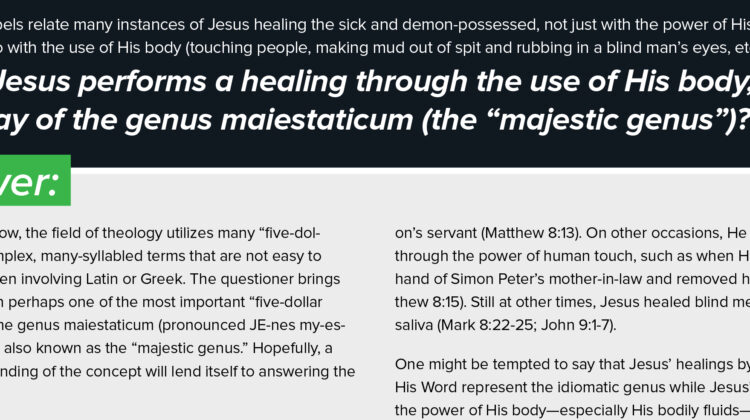
The four Gospels relate many instances of Jesus healing the sick and demon-possessed, not just with the power of His Word, but also with the use of His body (touching people, making mud out of spit and rubbing in a blind man’s eyes, etc.). When Jesus performs a healing through the use of His body, is it a display of the genus maiestaticum (the “majestic genus”)?
As you well know, the field of theology utilizes many “five-dollar words,” complex, many-syllabled terms that are not easy to pronounce, often involving Latin or Greek. The questioner brings to our attention perhaps one of the most important “five-dollar words” of all: the genus maiestaticum (pronounced JE-nes my-es-TAH-tic-coom), also known as the “majestic genus.” Hopefully, a basic understanding of the concept will lend itself to answering the question.
What is the genus maiestaticum?
The majestic genus, or genus maiestaticum, is one of three categories theologians use to explain how the attributes (qualities or characteristics) of Christ’s divine and human natures relate to one another within their personal union according to the Scriptures. The other two genera are the idiomatic genus (genus idiomaticum) and the apotelesmatic genus (genus apotelismaticum).
Often when Scripture speaks about the person of Christ, the individual qualities of Christ’s divine nature and His human nature are ascribed to the whole person. For instance, in Romans 1:3-4, Paul writes of “Jesus Christ our Lord, who was born of the seed of David according to the flesh” (NKJV). We understand that Christ’s nature as true God does not have a human lineage. At the same time, we also understand that according to His human nature—“according to the flesh”—Christ is “born of the seed of David.” The facts of Jesus’ lineage and birth, however, are not just tied to His human nature alone, but to the entire person, Jesus Christ our Lord. (This is, essentially, the idiomatic genus.)
Yet within the personal union of Christ, something else is also taking place. While the divine and human natures remain separate and distinct, they exist in such close communion with one another that within the person of Christ the majestic attributes of His divine nature are communicated—or gifted—to Christ’s human nature. This is the majestic genus or genus maiestaticum. A wonderful example from Scripture is found in 1 John 1:7: the blood of Jesus Christ His Son cleanses us from all sin. In the act of justification not only the divine nature in Christ, but also His blood shed at the cross (according to His human nature), has the power to cleanse us from all sins.
Are Jesus’ miraculous healings a display of the genus maiestaticum?
Yes, Jesus’ miraculous healings display the genus maiestaticum—though perhaps not in the way you might think. Throughout the Gospels, we see Jesus heal the sick in a variety of ways. Sometimes He uses the power of His Word, as He did with the centurion’s servant (Matthew 8:13). On other occasions, He heals simply through the power of human touch, such as when He touched the hand of Simon Peter’s mother-in-law and removed her fever (Matthew 8:15). Still at other times, Jesus healed blind men with His own saliva (Mark 8:22-25; John 9:1-7).
One might be tempted to say that Jesus’ healings by the power of His Word represent the idiomatic genus while Jesus’ healings by the power of His body—especially His bodily fluids—represent the majestic genus. Yet the truth is that Jesus’ miracles are an example of both genera. The genus maiestaticum describes how the divine and human natures in Christ function all the time. From the time of His conception, both natures are present in the person of Christ all the time along with their unique attributes. The unique attributes of each nature are ascribed to the whole person all the time. Yet various majestic attributes of the divine nature are communicated or gifted to the human nature all the time—because the two natures are never separate from each other.
If you place a piece of iron into the blacksmith’s fire, it will receive within itself the attributes of the fire and glow red hot—even though iron by itself isn’t usually red hot. In a similar way, when Christ’s human nature was conceived in the womb of Mary, it began to receive in itself the attributes of His divine nature: God’s almighty power, omnipresence, and omniscience. The analogy limps somewhat in that iron can be pulled from the fire and thereby lose the attributes of fire. In contrast, the human nature and divine nature—while distinct and separate—are inseparable in the personal union of Christ.
In conclusion
If this month’s column went over your head a little, do not be discouraged. Doctrines such as the majestic genus are admittedly hard for most people to grasp without a careful study of the Scriptures. Don’t be afraid to ask your own pastor about this or any Bible teaching that you wrestle with. The word genus maiestaticum may be a “five-dollar word,” but rest assured it has an infinite value in helping us think about and teach the truth of God’s Word.
-Rev. S. Piet Van Kampen